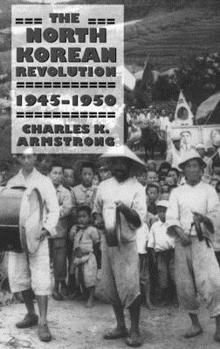The North Korean Revolution, 1945-1950
(Part of the Studies of the Weatherhead East Asian Institute, Columbia University Series)
Select Format
Select Condition 
Book Overview
North Korea, despite a shattered economy and a populace suffering from widespread hunger, has outlived repeated forecasts of its imminent demise. Charles K. Armstrong contends that a major source of North Korea's strength and resiliency, as well as of its flaws and shortcomings, lies in the poorly understood origins of its system of government. He examines the genesis of the Democratic People's Republic of Korea (DPRK) both as an important yet...
Format:Paperback
Language:English
ISBN:0801489148
ISBN13:9780801489143
Release Date:February 2004
Publisher:Cornell University Press
Length:288 Pages
Weight:0.98 lbs.
Dimensions:0.7" x 6.1" x 9.0"
Age Range:18 years and up
Grade Range:Postsecondary and higher
Customer Reviews
2 ratings
Solid, detailed, and thorough.
Published by Thriftbooks.com User , 17 years ago
When the history of North Korea is discussed, the focus is usually on the division of the peninsula, the installation of a pro-Soviet regime, and the application of communism. But Charles K. Armstrong went far beyond this approach in this work. Armstrong went through several aspects of North Korean society, touching upon even art, to show how the government's authority and ideology touched upon every aspect of daily life and every imaginable segment of society. To his credit, he highlights the communists' significant overturning of traditional Korean classes, as the communists placed the peasantry on top. A sound work free of political bias which examines what the North Koreans did between August 14, 1945 and June 25, 1950, in their attempt to revolutionize their half of the peninsula.
Excellent study on the development of communist North Korea
Published by Thriftbooks.com User , 20 years ago
In The North Korean Revolution 1945-1950, Charles K. Armstrong argues that North Korea was not simply the result of an externally imposed communist system strictly controlled by the Soviet Union - and that Kim Il Sung was not a hand-picked Soviet puppet. Instead, he argues that North Korea, though created under the umbrella of the occupying Soviets, developed a uniquely Korean form of communism forged from the experiences of the various Korean communist groups that returned or re-emerged after liberation. Throughout the book, Armstrong strives to demonstrate the uniquely indigenous Korean aspects of the social formation of North Korea into a communist state - particularly those that contrast the Soviet national model and the type of socialism imposed more strongly on the Eastern European states. Armstrong begins his argument by discussing how socialist endeavors at land reform in Manchuria amongst the large populations of ethnic Koreans directly influenced subsequent land reforms in North Korea after Soviet occupation. Armstrong uses this one example to illustrate that an indigenous communist movement not only existed in theory in colonial Korea, but also actually put their theories into practice amongst the ethnic Korean population of Manchuria. Armstrong also notes that this nascent Korean communist movement, that existed to a limited extent within Korea and also in other countries where Koreans emigrated to or fled, was neither created nor controlled by the Soviet Union. In fact, when Soviet forces occupied North Korea, they had no known communist groups with which they had contact. Also, Armstrong makes the claim that the Soviets did not necessarily plan on creating a communist state in the North - only a state that would be friendly with the Soviet Union and open up its economic resources. Further, the various communist groups that eventually poured back into Soviet-occupied Korea did not all have the same agenda and competed amongst each other for influence. Armstrong also strongly emphasizes in this book that Kim Il-Sung was not the hand-picked puppet leader of the Soviet authorities, but was rather a leader of one of the several returning communist factions who had to compete for his ultimate leadership of the North. After making these significant points in his argument, Armstrong spends the rest of the book demonstrating how the communism that developed in North Korea from 1945 to 1950 was more a result of both traditional Korean Confucian traditions and the complex influence of oppression under and resistance to the Japanese colonial system than a result of an implementation of Soviet-style socialism. Armstrong also notes that North Korea had no real exposure to Western liberal ideals since it moved "directly from neo-Confucian monarchy to Japanese colonialism to Stalinism virtually without a break (6-7)." Finally, Armstrong shows throughout his book, and especially in the last few chapters, the influence of the anti-Japanese






